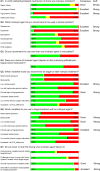Current use of inotropes in circulatory shock
- PMID: 33512597
- PMCID: PMC7846624
- DOI: 10.1186/s13613-021-00806-8
Current use of inotropes in circulatory shock
Abstract
Background: Treatment decisions on critically ill patients with circulatory shock lack consensus. In an international survey, we aimed to evaluate the indications, current practice, and therapeutic goals of inotrope therapy in the treatment of patients with circulatory shock.
Methods: From November 2016 to April 2017, an anonymous web-based survey on the use of cardiovascular drugs was accessible to members of the European Society of Intensive Care Medicine (ESICM). A total of 14 questions focused on the profile of respondents, the triggering factors, first-line choice, dosing, timing, targets, additional treatment strategy, and suggested effect of inotropes. In addition, a group of 42 international ESICM experts was asked to formulate recommendations for the use of inotropes based on 11 questions.
Results: A total of 839 physicians from 82 countries responded. Dobutamine was the first-line inotrope in critically ill patients with acute heart failure for 84% of respondents. Two-thirds of respondents (66%) stated to use inotropes when there were persistent clinical signs of hypoperfusion or persistent hyperlactatemia despite a supposed adequate use of fluids and vasopressors, with (44%) or without (22%) the context of low left ventricular ejection fraction. Nearly half (44%) of respondents stated an adequate cardiac output as target for inotropic treatment. The experts agreed on 11 strong recommendations, all of which were based on excellent (> 90%) or good (81-90%) agreement. Recommendations include the indications for inotropes (septic and cardiogenic shock), the choice of drugs (dobutamine, not dopamine), the triggers (low cardiac output and clinical signs of hypoperfusion) and targets (adequate cardiac output) and stopping criteria (adverse effects and clinical improvement).
Conclusion: Inotrope use in critically ill patients is quite heterogeneous as self-reported by individual caregivers. Eleven strong recommendations on the indications, choice, triggers and targets for the use of inotropes are given by international experts. Future studies should focus on consistent indications for inotrope use and implementation into a guideline for circulatory shock that encompasses individualized targets and outcomes.
Keywords: Acute circulatory failure; Cardiac output; Cardiogenic shock; Catecholamines; Inotropes; Levosimendan; PDE-inhibitors; Resuscitation; Sepsis; Septic shock; Vasoactive agents.
Conflict of interest statement
A.M. received speaker’s honoraria from Novartis, Orion, and Servier and fees as a member of the advisory board or steering committee from Adrenomed, Sanofi, Roche, Abbott, and 4TEEN4. The other authors have no competing interest to declare regarding this paper.
Figures

References
Grants and funding
LinkOut - more resources
Full Text Sources
Other Literature Sources
Miscellaneous

